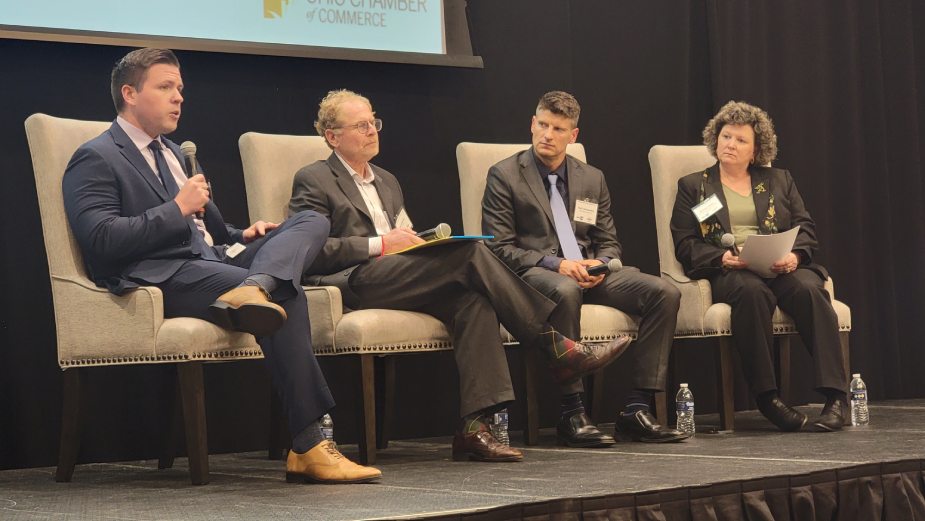Mahoning Valley Firefighters, EMTs Share Camaraderie As First to Respond
YOUNGSTOWN, Ohio – The first time Nick Heitzer rode in a fire truck he was 17 years old.
A student at Austintown Fitch High School at the time, Heitzer planned to go to college and play baseball. But at the behest of his father, a captain with the Austintown Township Fire Department, Heitzer spent a few days riding along.
On the first day of his ride-along, the crew was called to a structure fire. The second ride was a cardiac arrest. For someone still in high school, Heitzer says he handled the situations well.
“That was really the turning point for me to realize that this was something I wanted to make a career of,” he says.
Today, as an active firefighter with the Austintown department, Heitzer shared his story during a Brain Gain Navigators webinar hosted by The Business Journal. He was joined by his colleagues at the department: Chief Andy Frost, Battalion Chief Tom O’Hara and Judy Hartley, an Austintown firefighter and EMT/paramedic with Lane Lifetrans.
All four individuals are also instructors at the Mahoning County Career and Technical Center Adult Career Center.
Gallery images include MCCTC fire instructors Nick Heitzer, Judy Hartley, Chief Andy Frost and Battalion Chief Tom O’Hara.
Brain Gain Navigators webinars are designed to show young people that jobs are plentiful here as well as training programs for specific skills. The webinars are shared with Junior Achievement and shown in classrooms across the Mahoning Valley.
Firefighters and EMT/paramedics must be prepared for anything when they answer a call, Heitzer says. When they arrive at a scene, they could be dealing with anything from a drug overdose to someone in cardiac arrest to having to perform CPR on a victim in front of family members.
“When we’re on our way to the call, we could prepare as much as we want for what [the dispatcher] is telling us,” he says. “But when you walk in, it could always be something different.”
At MCCTC, students receive training in firefighting and medical procedures. The school also has a partnership with University Hospitals to provide a paramedic program, Chief Frost says.
“We want you to come here, start here, and in a year-and-a-half to two years, you leave here fully trained,” Frost says. “You can go anywhere in the country and get a job.”
MCCTC has firefighter/EMT graduates working in 43 states, he says.
During a visit to the MCCTC fire training center, John Lightly, fire program instructor and a Youngstown Fire Department battalion chief, demonstrated some of the equipment students are trained to use, such as hoses, self-contained breathing apparatuses and saws.
Students should show an aptitude for math and science, particularly biology and anatomy. On the fire-fighting side of the program, the training gets heavily into the trades, such as carpentry, electrical work and welding, Lightly says.
“We do a little bit of all of that,” he says.
Becoming a full-time certified firefighter in Ohio requires 260 hours of training, says battalion chief O’Hara. At the MCCTC adult career center, that training is divided between Fire 1 and Fire 2.
Students learn about fire behavior, personal protective equipment and turnout gear, climbing ladders, using fire extinguishers, fire attack or fire suppression and ventilation, among other training. An emergency vehicle operator course trains students how to drive an emergency vehicle.
EMS training is also included, O’Hara notes, such as first-aid and CPR.
After receiving certification, which must be renewed every three years, Ohio firefighters must complete 18 hours of continuing education annually, he says, and new specialties are always coming out.
“We are teaching you how to be a firefighter. When we get you on the job, we never want you to stop learning and progressing and improving your education,” O’Hara says.
Gallery images include MCCTC students Toby Mizway and Derrick Thomas gearing up for live burn training at the school, as well as shots of the live burn simulation.
Firefighters can go on to receive specialized training, such as a firefighter engineer, which is a pump-operator class. That training provides a better understanding of how to operate a pump and to apply the correct amount of hose and water pressure to extinguish the fire in a timely manner.
“Everything starts at the pump,” O’Hara says. “If we don’t have the firetruck or the pump, it’s hard for us to get the water on the fire.”
While physical traits “help tremendously,” Frost says instructors look for a particular type of person who would be a good fit for the job. Ultimately, they want a good person.
“We can train them to do everything that needs done, but what we can’t do is train them on how to be a good, caring person,” Frost says. “That is one of the traits that I really look for, especially when I’m doing the hiring for my department.”
Firefighters typically work a 24-hour shift, followed by 48 hours off. They can expect to see several outdoor fires weekly – wood fires or car fires – and an average of one to two structure fires monthly, depending on one’s service area. Firefighters in busier cities could see one or two structure fires daily.
While on the clock, firefighters live at the fire station, which has bedrooms and a kitchen. That breeds a sense of camaraderie and team atmosphere, Frost says.
“You’re going to come to work with these folks at 8 a.m. and you’re going to be with them until 8 o’clock tomorrow morning,” he says. “And you have no idea what you’re going to get into, which is part of the fun of this job.”
During a snowy winter night, Hartley, from Lane Lifetrans, didn’t know she would help to deliver a baby during one of her shifts. The couple was on the way to the hospital for their first child, she says.
“They were within sight of the hospital when she said, ‘I can’t wait any longer.’ They pulled over and called 911,” Hartley says.
“I was the one that got to catch the baby,” she continues. “I believe it was a girl and it was a pretty awesome experience.”
Fortunately, delivering a baby is covered in EMT training, she says.
An EMT is the first step toward becoming a paramedic, and comprises about 16 weeks of learning more in-depth first aid – for adults, children and pets – and the types of medication an ambulance stocks.
To become a paramedic, “the big dog on the truck,” Hartley says, takes another year and a half of training.
“Paramedic is a very tough course. But it’s very rewarding,” she says. “And there’s certain things you have to meet before you get to the end of the course.”
That includes 400-plus hours of clinical time in the ambulance and in hospitals, she says. Paramedics must be able to perform drug calculations and have a knowledge of how the body works, making math, anatomy and physiology very important.
Before her paramedical training, Hartley went through surgical tech school at Choffin Career & Technical Center, where she says she realized she wanted more connection and communication with the patient, and to be the first point of contact.
She obtained her paramedic certification in 2006. A few years ago, she decided to pursue fire training, “and probably should have done it sooner,” she says.
Heitzer and Hartley say they attended fire school in their 20s.
Heitzer recommends students take advantage of opportunities when they are younger. Successfully completing fire-fighting courses in high school could help students get jobs as firefighters where they earn $30,000 to $40,000 to start upon graduation, he says.
Paramedics in the Mahoning Valley typically start at $18 hourly, with the average salary around $40,000, Hartley adds.
Among the challenges firefighters and paramedics face is the stress of the job, they say.
“You do get some scenes that could be deemed unsafe,” Hartley says. “Patients get combative.”
Whether a fire or medical scene, one of the first things MCCTC teaches students is how to keep themselves, their teammates and their patients safe.
“That is what we deal with everyday,” Hartley says.
Going into those scenes requires putting on “your game face” and keeping a positive mental attitude, Heitzer adds. That can be difficult when working with patients or family members who are dealing with the emergency in their own way.
“It takes a mental toll on you,” he says. “And that’s why I think mental preparation is an important part of this job.”
For Heitzer, being around his colleagues helps. He went on his first difficult call when he was 19. He says the only people he had to lean on are the ones who had been in a similar situation during their careers, he says.
“You come back. You talk about it. And being able to do that helps you through it,” Heitzer says.
Copyright 2024 The Business Journal, Youngstown, Ohio.











